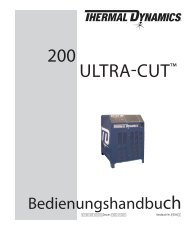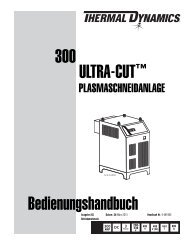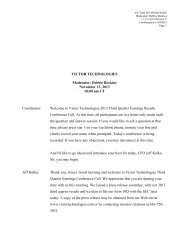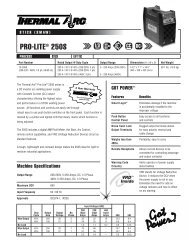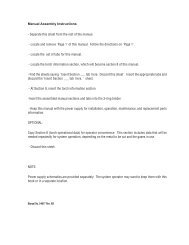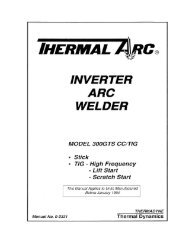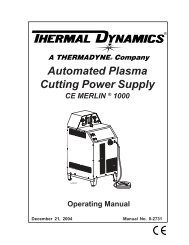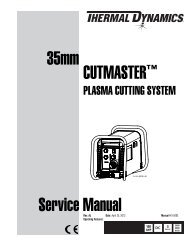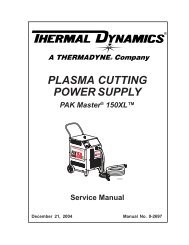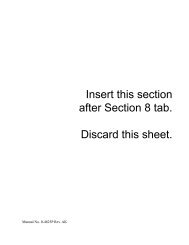POWER-MASTER 500 - Victor Technologies
POWER-MASTER 500 - Victor Technologies
POWER-MASTER 500 - Victor Technologies
You also want an ePaper? Increase the reach of your titles
YUMPU automatically turns print PDFs into web optimized ePapers that Google loves.
5. Work in a confined space only if it is well ventilated,<br />
or while wearing an air-supplied respirator.<br />
Shielding gases used for welding can displace<br />
air causing injury or death. Be sure the<br />
breathing air is safe.<br />
6. Do not weld in locations near degreasing, cleaning,<br />
or spraying operations. The heat and rays<br />
of the arc can react with vapors to form highly<br />
toxic and irritating gases.<br />
7. Do not weld on coated metals, such as galvanized,<br />
lead, or cadmium plated steel, unless the<br />
coating is removed from the weld area, the area<br />
is well ventilated, and if necessary, while wearing<br />
an air-supplied respirator. The coatings and<br />
any metals containing these elements can give<br />
off toxic fumes if welded.<br />
WARNING<br />
WELDING can cause fire or explosion.<br />
Sparks and spatter fly off from the welding arc.<br />
The flying sparks and hot metal, weld spatter,<br />
hot workpiece, and hot equipment can cause fires<br />
and burns. Accidental contact of electrode or<br />
welding wire to metal objects can cause sparks,<br />
overheating, or fire.<br />
1. Protect yourself and others from flying sparks<br />
and hot metal.<br />
2. Do not weld where flying sparks can strike flammable<br />
material.<br />
3. Remove all flammables within 35 ft (10.7 m) of<br />
the welding arc. If this is not possible, tightly<br />
cover them with approved covers.<br />
4. Be alert that welding sparks and hot materials<br />
from welding can easily go through small cracks<br />
and openings to adjacent areas.<br />
5. Watch for fire, and keep a fire extinguisher<br />
nearby.<br />
6. Be aware that welding on a ceiling, floor, bulkhead,<br />
or partition can cause fire on the hidden<br />
side.<br />
7. Do not weld on closed containers such as tanks<br />
or drums.<br />
8. Connect work cable to the work as close to the<br />
welding area as practical to prevent welding current<br />
from traveling long, possibly unknown paths<br />
and causing electric shock and fire hazards.<br />
9. Do not use welder to thaw frozen pipes.<br />
10. Remove stick electrode from holder or cut off<br />
welding wire at contact tip when not in use.<br />
WARNING<br />
FLYING SPARKS AND HOT METAL can<br />
cause injury.<br />
Chipping and grinding cause flying metal. As<br />
welds cool, they can throw off slag.<br />
1. Wear approved face shield or safety goggles.<br />
Side shields recommended.<br />
2. Wear proper body protection to protect skin.<br />
WARNING<br />
CYLINDERS can explode if damaged.<br />
Shielding gas cylinders contain gas under high<br />
pressure. If damaged, a cylinder can explode.<br />
Since gas cylinders are normally part of the welding<br />
process, be sure to treat them carefully.<br />
1. Protect compressed gas cylinders from excessive<br />
heat, mechanical shocks, and arcs.<br />
2. Install and secure cylinders in an upright position<br />
by chaining them to a stationary support<br />
or equipment cylinder rack to prevent falling<br />
or tipping.<br />
3. Keep cylinders away from any welding or other<br />
electrical circuits.<br />
4. Never allow a welding electrode to touch any<br />
cylinder.<br />
DATE: October 11, 2004 1-3 GENERAL INFORMATION



